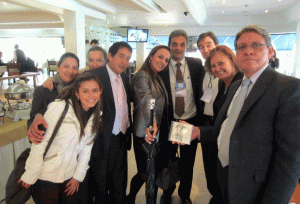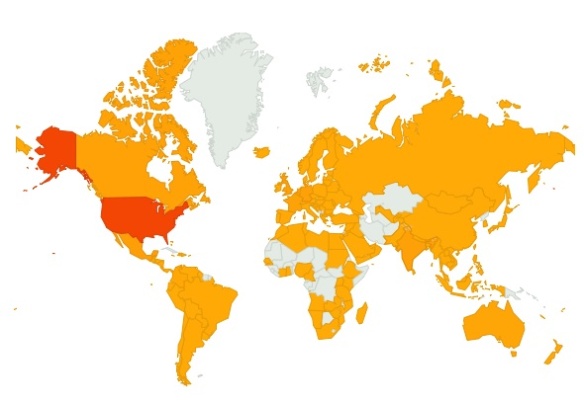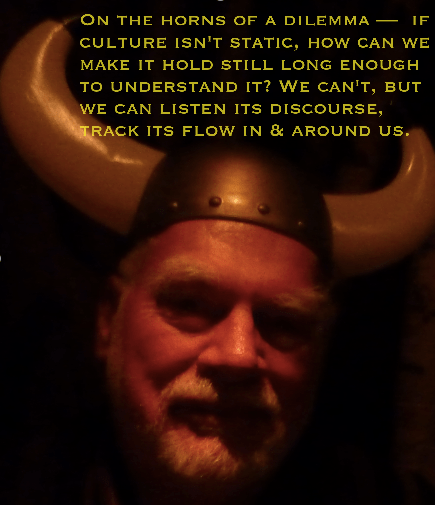 In the first three posts ( (#1 in the series, #2 in the series, #3 in the series), I have been hinting at a metaphor for culture that I will explicitly discuss in this post. Let me introduce it with a poem, Culture’s Flow.
In the first three posts ( (#1 in the series, #2 in the series, #3 in the series), I have been hinting at a metaphor for culture that I will explicitly discuss in this post. Let me introduce it with a poem, Culture’s Flow.
Old conversations and new
Sometimes I ask my trainees or students to close their eyes and imagine culture as this river. Its source, high on a mountaintop, starts with the melting ice that flows from the glacial peaks where the old wisdom of our people and our history has been stored from time beyond memory. In our primeval stream of culture are stories that have been handed down for generations—they carve the deep river bed for the stream of the discourse that flows within us.
Fresh waters of discourse, tributaries join our river’s flow from other places, from others’ mountaintops, from forest-hidden springs and history-pooled rainstorms of experience. Our stream collects, incorporates, assimilates endless sources of discourse. We absorb conversations from face-to-face contact with each other, hear rumors from elsewhere. Especially today, we are inundated by electronic streams of discourse from all over the globe, pouring through virtual media, sometimes going viral. If you’re in social networks, you may get more stories, ideas, reflections, comments than you know what to do with. They overflow your banks. Little by little, and large by large, sometimes tiny imperceptible memes, sometimes by seeping flood, sometimes by tempest and tsunami, they join this river, widen and deepen it and increase its flow. There are stagnant backwaters and rich deltas.
The mix
Discourses intersect. Some join the deeper currents; others cause raging rapids and whirlpools of power and contradiction. We belong and contribute to all kinds of discourses. Everything from our nation to our favorite football team has its story, a discourse about who we are and what we are about. These discourses meet in us to create our culture, shape what we call our person and personality. They produce the endless conversation that we have with ourselves, as we noted last time. We group ourselves with others by the importance, the gravity, and the glue of what we see as our common discourse. The river is meant to nourish the land it cuts through.
When we talk about waters of ancestral glaciers for centuries, we could call them our “primitive conversations,” origins lost in time, those that we share. Then there are “prevailing conversations,” discourse in the air, on the airwaves in cyberspace, conversations that we hear and think about or just absorb, that reflect the cultural values of the specific contexts that we find ourselves in. Prevailing conversations may indeed seem different from the original ones, but then again, not always. Culture is enduring. Its discourses don’t go away, but they flow deeply and they intimately blend with the discourses of the current moment, carrying them along in the river’s course.
Forever old, forever new (Plus ça change, plus c’est la même chose!)
When I was growing up, if you needed to take care of yourself, you went to the doctor and did what the doctor told you. A generation or so later, many of us got into natural foods, natural healing and healers. It looked like a cultural revolution. What didn’t change, but actually got stronger, was the discourse that ran, “I can control my health if I do all the right things.” It is a discourse related to, “I can control my life.” “I can control my career,” etc.”
I remember a European colleague once saying to me, “You Americans think if you do all the right stuff, you can live forever.” He didn’t share my strong US discourse of control, the belief that we are in charge, or think we should be. When I was younger, medical doctors were gods (maybe they still are in some places). Now there are prevailing discourses that tell us that we can diagnose our own problems, for example, through websites like WebMD. What happens when we discuss the problems with only relying on prevailing discourse in spite of older wisdom? While Internet information may help us ask good questions, self-diagnoses based on Internet searches can also go horribly wrong.
That is just one example of how, hearing the prevailing discourse, we may think it’s far afield from primitive wisdom. Yet looking carefully, we may find that it’s just a fresh way of expressing a more ancient discourse flowing from the river’s deep streams. Sometimes there are landslides and earthquakes, events so deep and moving that they may seem to dam up the river and alter its direction, but the power of water…
Seeing culture as a river with both ancient sources fresh inflows helps us see how streams of culture combine to create our reality. We are in a cultural flow. The metaphor allows us to visualize and acknowledge the strong streams and the mix, to accept and speak about both the endurance and the flexibility, the fluidity of culture.
 Full, not empty
Full, not empty
More importantly, this metaphor helps us imagine culture as inner fullness of stories and their discourse, replete with possibilities, not emptiness or alienation from our sources. Culture is forever flexible, forever moving, something that belongs to us, something that can irrigate our land and shape our landscape. Flow makes it invalid, impossible for me to stereotype or to label others or myself in fixed, inflexible ways, because we’re all part of the Flow.
Flow is everywhere, everything is flowing. We can see it, we can describe it, we hear its discourse and build our worlds with it. Yet, as the sixth century philosopher, Simplicius of Cicilia said, “You can’t step into the same river twice.” Why? The river has flowed on and you have changed as well. The challenge of viewing culture as a flowing river is that it requires us to accept that we have both inherited and that we continue to create, shape, dismantle, and destroy through the discourses that flow within us.
What can we do with this metaphor?
We can learn about ourselves and about the groups we are part of, identifying, reflecting on and taking ownership of our cultural streams. We can seek out our deepest discourse, the primitive undertows, as well as listen our prevailing self-talk and the chatter around us. We can ask what conversations are “primitive” and which are “prevailing.” What words and tones of our mother’s voice do we still hear, for example? For a humorous but confirming evidence of mother’s voice, listen to Anita Renfroe’s “The Mom Song.”
We can list or map our discourse and the courses it takes us on. I have often recommended using a personal journal for this—some years back I created a handbook on personal writing that is downloadable. When you wish to share, or explore a group’s cultural discourse, a personal or shared blog or a Facebook or LinkedIn group could focus on identifying the streams of identity we take part in. Colleagues and I developed a tool called the Cultural Detective: Self Discovery that provides some basic exercises for identifying our own or our organization’s core values, looking at how our discourse was and is being shaped by people and forces in our story. Mind mapping can be a resource for this. I use MindManager but there are quite a few software tools for this. Take a walk along your river and see what you can see…
—
This post originally appeared in the blog of the Center for Intercultural New Media Research and is provided with the assistance of its editor Anastacia Kurylo.














